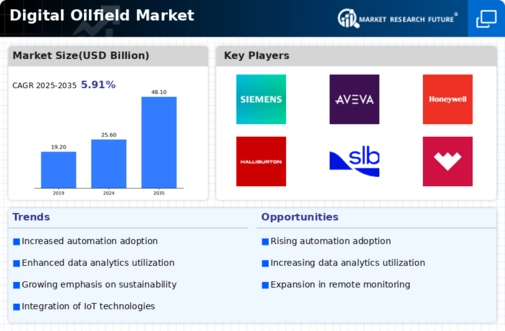Top Industry Leaders in the Digital Oilfield Market

*Disclaimer: List of key companies in no particular order
The digital oilfield market, driven by technology, is dynamically transforming the oil and gas industry. It is characterized by intense competition among established players and innovative newcomers, all driven by the pursuit of operational efficiency, cost reduction, and resource optimization. In this analysis, we explore the competitive landscape, examining key player strategies, market share dynamics, emerging trends, and the overall scenario.
Key Players and Strategies: Leading the pack are technology giants Schlumberger, Halliburton, and Baker Hughes, utilizing their extensive experience and global reach. They focus on strategic partnerships, acquisitions, and internal R&D efforts to maintain dominance. For instance, Schlumberger emphasizes integrated automation platforms, Halliburton offers cloud-based digital solutions, and Baker Hughes provides AI-powered offerings.
A new wave of nimble, technology-focused companies, including Emerson Automation Solutions, Rockwell Automation, and AVEVA, is rapidly gaining ground. These challengers leverage expertise in industrial automation and data analytics to offer flexible, scalable solutions at competitive prices. Emerson emphasizes edge computing and cloud integrations, Rockwell focuses on open interoperability platforms, and AVEVA offers a cloud-based industrial software suite.
Numerous smaller companies specialize in specific digital oilfield segments, collaborating with larger players to fill critical gaps in the market. Examples include CGG Veritas in seismic imaging, Wellbore Integrity Solutions in well integrity assurance, and Petroleum Experts in reservoir simulation software.
Factors for Market Share Analysis: Key factors include offering a comprehensive suite of hardware, software, and services; global reach and service network; data analytics and automation expertise; cybersecurity and data integrity; and cost-effectiveness and scalability.
Emerging Trends and Company Strategies: Trends include the shift towards cloud-based digital oilfields, led by players like Halliburton and AVEVA. Integration of AI and ML into field operations is unlocking predictive maintenance and automated drilling processes, exemplified by Schlumberger's AI-powered drilling optimization platform. Digital twins and integrated workflows, as demonstrated by Emerson's Plantweb Optics platform, enable real-time performance monitoring and optimization. There's also a focus on environmental sustainability, with solutions such as Baker Hughes' EcoLab suite.
Overall Competitive Scenario: The digital oilfield market is marked by intense competition, with established players leveraging resources and experience, while agile challengers and niche specialists disrupt the landscape. Technological advancements, customer-centric solutions, and data-driven insights are key differentiators. The market is expected to remain dynamic, with trends like cloud computing, AI, and digital twins shaping the competitive landscape.
Industry Developments and Latest Updates:
- Schlumberger announced collaboration with Microsoft for AI-powered solutions.
- Weatherford reported strong growth in its digital products and services segment.
- Halliburton launched a new cloud-based platform for real-time reservoir monitoring.
- National Oilwell Varco showcased advancements in automation and digital solutions for drilling and completions operations.

